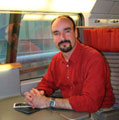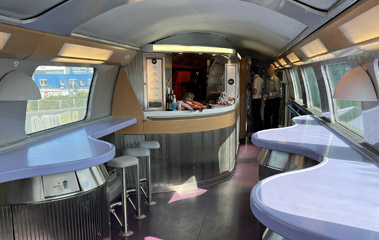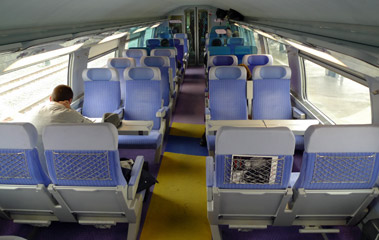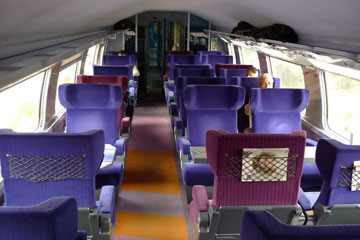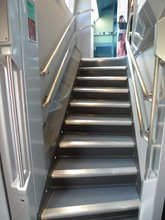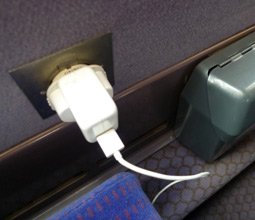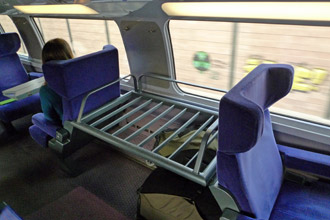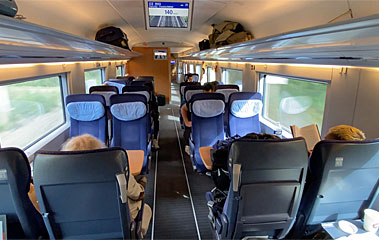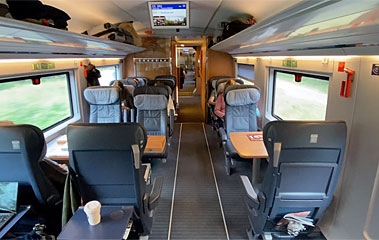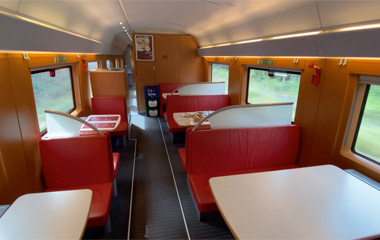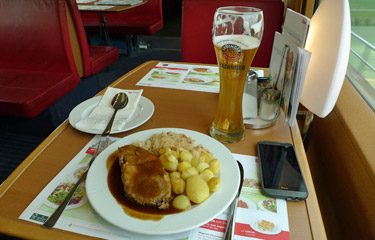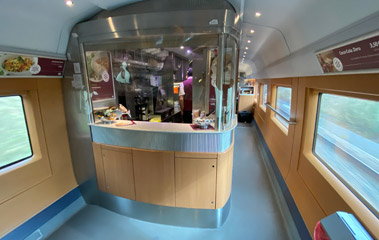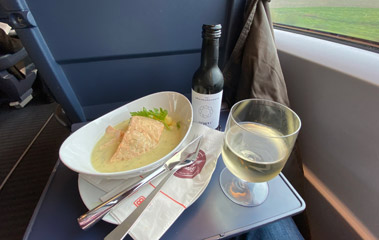 |
|
|
TGV Duplex & ICE3 side by side at Paris Est. Trains from Paris to Frankfurt & Stuttgart are jointly run by the French & German national railways. |
Paris to Germany from €39.90
Trains between Paris Gare de l'Est and Saarbrücken, Karlsruhe, Mannheim, Frankfurt (Main), Stuttgart & Munich are run by SNCF (French Railways) and DB (German Railways) in co-operation. In addition, one service a day links Frankfurt with Lyon, Avignon & Marseille. Some services are operated by French TGV Duplex trains, others by German ICE3 trains, usually of the latest class 407 type. This page explains what the trains are like with tips for using them.
Paris-Germany routes, DB & SNCF in co-operation:
Paris - Mannheim - Frankfurt (via Saarbrücken or via Strasbourg & Karlsruhe)
Paris - Strasbourg - Karlsruhe - Stuttgart - Munich
Frankfurt - Strasbourg - Lyon - Avignon - Marseille
![]() Tips for travel by TGV Duplex
& Video guide
Tips for travel by TGV Duplex
& Video guide
![]() Tips for travel by ICE
& Video guide
Tips for travel by ICE
& Video guide
TGV Duplex
These 320 km/h (199 mph) double-deck high-speed trains have a cafe-bar, power sockets at all seats & free WiFi. There are luggage racks and toilets both upstairs and downstairs, you walk through the train at the upper level. I recommend an upper deck seat for the best views, any seat number greater than 60 is upper deck. TGV stands for Train á Grande Vitesse, which simply means high-speed train in French. French Railways premier TGV services are now branded TGV-InOui, which literally means unheard of, in the sense of exceptional.
The direct TGV Duplex from Frankfurt to Marseille, ready to leave Frankfurt am Main Hbf.
Tips for travel by TGV Duplex
-
Do you need to book in advance?
Reservation is compulsory on these trains for journeys to, from or within France and a reserved seat will automatically be included on your ticket. There are normally plenty of places available even on the day, the issue is price: In advance, fares start at €39.90, on the day you'll pay the expensive full-flex fare. So book ahead! These trains are reservation optional for journeys wholly within Germany just like other German trains. A small LED display above each seat shows whether the seat is reserved or available.
-
Should you go 1st or 2nd class?
2nd class is perfectly comfortable, there's no need to pay for 1st class unless you really want to and can afford it. There is no food or drink included in the 1st class fare, it's just the extra space and legroom that you're paying for. On the other hand, first class seats are arranged 2+1 across the car width, so there are individual 'solo' seats and tables-for-two in 1st class as well as the dual-side-by-side and tables-for-four which you'll also find in 2nd class where seats are arranged 2+2 across the car width. Prices vary in both classes, so sometimes 1st class is little more (and can even cost the same or less) than 2nd class, so see what prices you get for each class before you decide.
-
Upper or lower deck?
I recommend an upper deck seat for the best views. There are just 9 wide & shallow steps up from the entrance to the upper deck, and once upstairs you can walk along the train to the cafe-bar, there are toilets & luggage space. Any seat number over 60 is upper deck. You'll normally get a choice of deck when you book.
-
Forward-facing seats & tables
All seats have tables, either a large fixed table between face-to-face seats or a smaller drop-down table attached to the seat back in front. If you'd like seats at a larger fixed table, you can select Open saloon with table when you book. You can't specify a forward-facing seat as the reservation system doesn't know which way round the TGV will enter service, but if you're a couple in 1st class, a face-to-face table-for-two is the nicest option (select Open saloon with table) and then at least one of the seats will face forward. In 2nd class, the best option for a family is a table for four, again you'd select Open saloon with table.
-
Seat maps
See the seat maps page and look for TGV Duplex 3rd generation.
-
The best place to wait for your train
For suggested places to wait for your train in Frankfurt or Munich, see the guides to Paris Gare de l'Est, Frankfurt (Main) Hbf or Munich Hbf.
-
Boarding your train
As with virtually all European trains, there's no check-in. Just walk into the station, find your train and get on, any time before it leaves. Be aware that the train doors may be closed a minute or two before departure. In Paris, platforms at the main Paris stations now have automatic ticket gates, you place the barcode on your ticket, printout or phone against the scanner to open the gates and access the platforms. There's usually an extra-wide gate if you have large luggage or a pushchair. The gates are usually closed a couple of minutes before departure.
Frankfurt (Main) Hbf, Munich Hbf, Stuttgart Hbf & Paris Gare de l'Est are all termini, so there's step-free access from street to concourse to platform, no problem accessing trains with wheeled luggage or with mobility problems. At German stations, a poster on the platform shows where each car will stop along the platform. This saves you running up and down like a headless chicken when the train comes in, trying to find your car.
-
Luggage
Luggage works just as it does on any other European train. For all practical purposes you can take what you want, nobody weighs or measures it, you simply take your bags onto the train with you and park them on the racks between the seats or at the car ends. There are racks both upstairs & downstairs, and the stairs to the upper deck are shallow and wide enough to make taking bags upper deck pretty easy. I always find a rack near my seat so I can see my bags from my seat. SNCF ask you to label your bags with at least your name. It's as simple as that, no luggage worries! More about luggage on European trains.
-
WiFi & power sockets
These TGVs have free WiFi in both classes, and there's reasonable mobile data coverage along the route. All seats have power sockets, of the usual European 2-pin type.
Tip: SNCF TGV WiFi requires you to enter your booking reference. It works with an SNCF booking reference, but not with a DB reference.
-
Food & drink
These TGVs have a cafe-bar on the upper deck or a car in the middle of the train, between the 1st & 2nd class sections. It sells snacks, microwaved hot dishes, salads, tea, coffee, hot chocolate, beer, wine & spirits. The coffee is good, credit cards are normally accepted as well as cash. There is a standing area where you can eat & drink or you can take your purchases back to your seat.
Tip: On many TGVs you can now log onto the train's WiFi, find the SNCF intranet and order items from the bar on your laptop or phone. They'll give you a 15-minute time slot for picking it up from the cafe-bar counter, but you'll skip right to the front of the queue to pick up your food & drink, potentially saving a lot of time waiting in line to be served. I haven't been able to confirm that this option is available on this route, so feedback would be appreciated!
You are of course free to bring your own food & drink along (even a bottle of wine) if you like, to consume at your seat.
-
Toilets, baby-changing facilities, smoking...
Like most European trains, TGVs are all non-smoking. There are toilets in every car, both upstairs and downstairs, and some toilets have baby-changing facilities too.
-
Important: Interrail & Eurail reservations
See the passholder reservation page for Interrail & Eurail reservation fees and how to make passholder reservations.
Do not make a normal seat-reservation-only booking for €5.20 on Germany-Paris TGVs/ICEs using int.bahn.de, as you would for other German trains. On TGV/ICE trains to/from Paris this is not sufficient as (a) the required passholder fee is significantly more than this and (b) you need a special passholder reservation taken from the limited quota for passholders. If you turn up with only a regular €5.20 seat reservation, you will (a) have to pay the difference, and (b) if the passholder quota is sold out you may not be allowed to travel.
-
What's the journey like? See below
Video guide: Munich to Paris by TGV Duplex
ICE3
ICE stands for Inter-City Express, the brand name for German Railways premier high-speed trains. There are various types of ICE (see the ICE page), but the type usually used on the services between Paris & Germany is ICE3 class 407, pictured below, running at up to 320 km/h (199 mph) on the high-speed line between Paris & the German border. You may notice the similarity to Eurostar's e320, it's the same basic train. These ICEs have a restaurant car, power sockets at all seats & free WiFi. However, unlike other ICE3s they don't have the viewing area at each end where you can look through the driving cab.
A Frankfurt to Paris ICE3 (class 407) at Frankfurt (Main) Hbf
An ICE3 (class 407) at Paris Gare de l'Est
Tips for travel by ICE
-
Do you need to book in advance?
Reservation is compulsory on these trains for journeys to, from or within France and a reserved seat will automatically be included on your ticket. There are normally plenty of places available even on the day, the issue is price: In advance, fares start at €39.90, on the day you'll pay the expensive full-flex fare. So book ahead! These trains are reservation optional for journeys wholly within Germany just like other German trains. A small LED display above each seat shows whether the seat is reserved or available.
-
Should you go 1st or 2nd class?
2nd class is perfectly adequate. But if you get a good price, 1st class offers more leg and elbow room and a quieter environment, with more laptops tapping and fewer kids. The only real difference is the seating quality, but in 1st class on ICEs food & drink orders are taken by a steward at your seat so you don't have to go to the restaurant car, a useful service. In 1st class seats are arranged 2+1 across the car width, so you'll find tables for two and solo seats as well as tables for four and dual side-by-side seats as in 2nd class. For couples a first class table for two is ideal, when booking at int.bahn.de simply select 'table' (Tisch in German).
-
Forward-facing seats & tables
All seats have tables, either a large fixed table between face-to-face seats or a smaller drop-down table attached to the seat back in front. If you'd like seats at a larger fixed table, you can select Open saloon with table when you book. You can't specify a forward-facing seat as the reservation system doesn't know which way round the train will enter service, but if you're a couple in 1st class, a face-to-face table-for-two is the nicest option (select Open saloon with table) and then at least one of the seats will face forward. In 2nd class, the best option for a family is a table for four, again you'd select Open saloon with table.
-
Seat maps
See the seat maps page and look for ICE3 class 407.
-
The best place to wait for your train
For suggested places to wait for your train in Frankfurt or Munich, see the guides to Paris Gare de l'Est, Frankfurt (Main) Hbf or Munich Hbf.
-
Boarding your train
As with virtually all European trains, there's no check-in. Just walk into the station, find your train and get on, any time before it leaves. The train doors may be closed a minute or two before departure. In Paris, platforms at the main Paris stations have been fitted with automatic ticket gates, you place the QR code on your ticket, printout or phone against the scanner to open the gates and access the platforms. There's usually an extra-wide gate if you have large luggage or a pushchair. The gates may be closed a couple of minutes before departure.
Frankfurt (Main) Hbf, Munich Hbf, Stuttgart Hbf & Paris Gare de l'Est are all termini, so there's step-free access from street to concourse to platform, no problem accessing trains with wheeled luggage or with mobility problems. At German stations, a poster on the platform shows where each car will stop along the platform. This saves you running up and down like a headless chicken when the train comes in, trying to find your car.
-
Luggage
Luggage works just as it does on any other European train. For all practical purposes you can take what you want, nobody weighs or measures it, you simply take your bags onto the train with you and park them on the various luggage racks. Anything up to and including backpack-size easily fits on the overhead racks above your seat on an ICE. There are also floor-standing racks at intervals between the seats on ICEs. SNCF ask you to label your bags with at least your name. More about luggage on European trains.
-
WiFi & power sockets
These ICEs have free WiFi in both classes and there's decent mobile data coverage along most of the route. All seats have power sockets, of the usual European 2-pin type.
The WiFi in 2nd class has limited bandwidth, so you can check your emails and browse the web but you won't be able to watch videos or download large attachments. In 1st class there's no artificial limit on bandwidth so you can access larger files & video.
To use the free WiFi, select the WIFIonICE network in your WiFi settings. This normally opens the landing page LogIn.WIFIonICE.de but if it doesn't you can open that link in a browser manually.
DB ICE WiFi works however you bought your ticket, unlike SNCF TGV WiFi which requires an SNCF ticket booking reference.
-
Food & drink
Catering on the ICE is much better than on the TGV. These ICEs have a proper waiter-service restaurant car, no reservation is necessary or possible, just go along and sit down. You can also order food & drink from the small cafe-bar counter at the other end of the restaurant car and take it back to your seat. In ICE 1st class, a steward takes food & drink orders from the restaurant menu and serves them at your seat, so there's no need to go to the restaurant car unless you really want to - a useful 1st class perk. Cash & cards are accepted.
You can find DB's menu for the current month in both html & pdf formats at www.bahn.de/service/zug/bordgastronomie, just click the Speisen & Getränke links at the bottom of that page -please let me know if that link stops working.
If you are a red wine fan, DB's Spätburgunder red is lovely. If you're a beer drinker, DB serves excellent Erdinger Weissbier in a distinctive tall Erdinger glass, highly recommended.
You are of course free to bring your own food and drink along if you prefer and consume it at your seat, as on any European train.
-
Toilets, baby-changing facilities, smoking...
Like most European trains, ICEs are all non-smoking. There are toilets in almost every car, some toilets have baby-changing facilities too.
-
Important: Interrail & Eurail reservations
See the passholder reservation page for Interrail & Eurail reservation fees and how to make passholder reservations.
Do not make a normal seat-reservation-only booking for €5.20 on Germany-Paris TGVs/ICEs using int.bahn.de, as you would for other German trains. On TGV/ICE trains to/from Paris this is not sufficient as (a) the required passholder fee is significantly more than this and (b) you need a special passholder reservation taken from the limited quota for passholders. If you turn up with only a regular €5.20 seat reservation, you will (a) have to pay the difference, and (b) if the passholder quota is sold out you may not be allowed to travel.
-
What's the journey like? See below
Video guide: Paris to Frankfurt by ICE3
Route maps
Click for larger Paris-Germany map Click for larger Frankfurt-Marseille map
Highlighted, left-hand map: Paris - Saarbrucken - Frankfurt, Paris - Strasbourg - Frankfurt, Paris - Stuttgart - Munich.
Highlighted, right-hand map: Frankfurt - Strasbourg - Lyon - Avignon - Marseille.
Red = high-speed lines. Green = scenic sections. Black = conventional lines.
Buy the map. Reproduced from the excellent European Rail Map with kind permission of the European Rail Timetable people. I recommend buying this European Rail Map (and the European Rail Timetable), they ship worldwide, www.europeanrailtimetable.eu.
What's the journey like?
The train leaves Paris and accelerates to 320 km/h (199 mph) on the TGV-Est high-speed line across rural France through the Champagne region. If your train is routed via Strasbourg (meaning all Paris-Stuttgart and some Paris-Frankfurt trains), look out for Strasbourg cathedral in the distance on the left soon after leaving Strasbourg station. It was to have two towers, but only the north tower was built (I always think it looks as if the south tower was launched!). Even so, that north tower was the world's tallest building from 1647 to 1874. Shortly afterwards the train crosses the river Rhine, which forms the border between France and Germany, before passing non-stop through Kehl. Once in Germany, the train uses classic lines at lower speed, with some stretches of new-build high-speed line.
Rural France at 320 km/h, from a Frankfurt to Paris ICE
Fares
-
Fares from Paris to Germany start at €39.90 in 2nd class or €69.90 in 1st class. Fares vary like air fares, so book ahead.
How to buy tickets
-
Buy tickets between Paris and anywhere in Germany at the German Railways website int.bahn.de.
You can also buy tickets at the French Railways website www.sncf-connect.com, but read the advice below.
-
Booking opens up to 6 months ahead. You print your own ticket or can show it on your laptop or phone.
-
Should you use int.bahn.de or www.sncf-connect.com?
If you're going deep into Germany, it's better to use int.bahn.de as the Germans sell through tickets to almost anywhere in Germany for one inclusive price (in principle, Paris-Berlin or Paris-Nuremberg from €39.90) whereas the French charge for each train, so that same Paris-Berlin journey might be €39.90 for the direct Paris-Mannheim train + another €40 for the Mannheim-Berlin train, making it significantly more expensive than buying from DB. It's just the different way the French & German ticketing systems work!
If you have kids, it's better to use int.bahn.de as if you buy from the Germans, the more generous German child age limits apply, under 6 free, under 15 child rate. Furthermore, DB have a permanent offer, children under 15 go free on the German component of the journey when accompanied by a parent, grandparent or guardian using a Sparpreis advance-purchase fare. If you buy from the French, under 4s go free, under 12 get the child rate, without the kids-go-free deal. So if you have children, it's a no-brainer to buy from the Germans.
If you're just using a direct train, say Paris-Frankfurt or Paris-Stuttgart, check both sites! I've seen int.bahn.de want €44.90 non-refundable for Paris-Frankfurt when www.sncf-connect.com wanted only €39 for exactly the same train, refundable less €15 up to 3 days before departure. Plus www.sncf-connect.com would let me hold the ticket at that price without payment for a week while I completed my planning. So I bought from www.sncf-connect.com! Plus www.sncf-connect.com will normally let you choose an exact seat from a plan when travelling first class on one of their TGV trains to or from Germany.
-
Tip: These jointly-run DB/SNCF ICE & TGV trains should not be confused with Paris-Cologne Eurostar (formerly Thalys) trains, Eurostar is a separate company owned by French, Belgian & Dutch Railways (and others) with no German Railways involvement. There are through tickets from Paris to almost anywhere in Germany using these DB/SNCF TGV/ICE trains & connecting DB trains, but no through tickets using Eurostar. So even if Cologne is the more direct route (such as Paris to Hamburg or Berlin), you are usually better off using a joint DB/SNCF service with a through ticket, in terms of both price and your legal rights if there's a missed connection.
